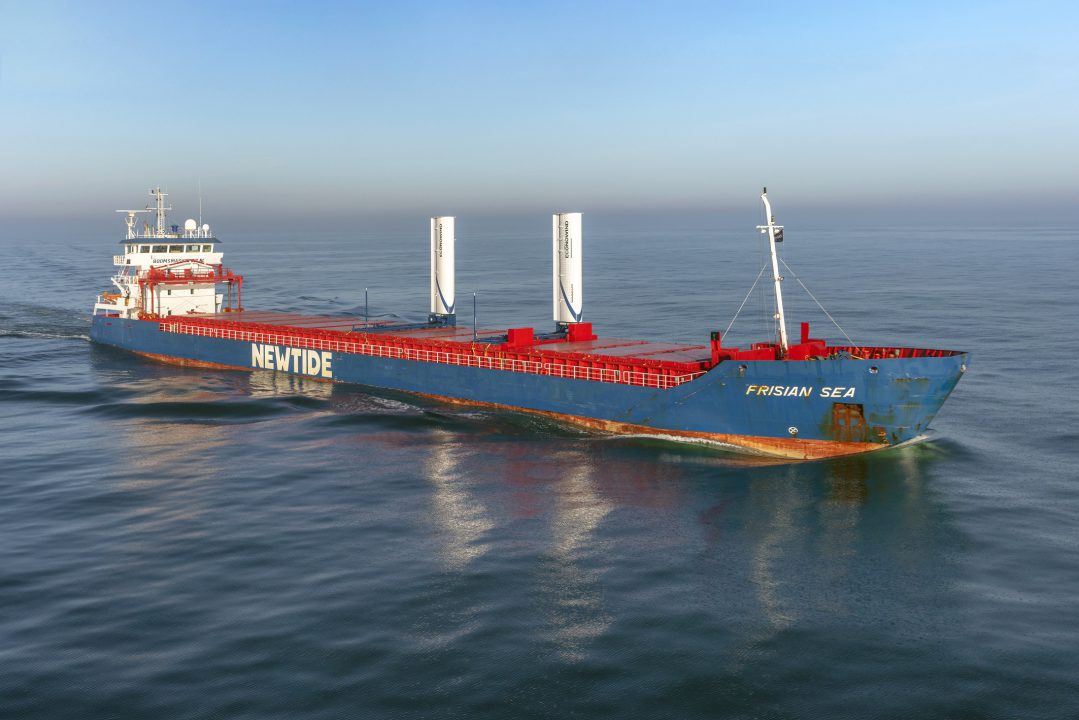Making shipping more sustainable is high on the agenda of shipping companies, shippers and policymakers. The IMO is developing international regulations and standards with a view to achieving a 40% CO2 reduction by 2030. eConowind contributes to this with its VentoFoil concept: a flexible, vertical ‘wing’ that converts wind into extra thrust. With this, ships can already save up to 15 per cent on their fuel consumption on an annual basis. As the first VentoFoil users are impressed, they now start to share their experiences with the market as official ambassadors.
With the start of the CO2 tax in 2024, it becomes important for ship owners to accelerate the green transformation. Especially now that industry and shipping are under the magnifying glass. International shipping accounts for 3 per cent of global CO2 emissions. Nevertheless, this mode of transport is still the most efficient per tonne-kilometre.
Frank Nieuwenhuis of eConowind says: “It is great to work in the energy transition and I am grateful for the efforts of these four innovators. With all the pooled knowledge and experience, we can make the wings more widely available. There is momentum and our order pipeline is well-stocked. Several shipping companies have closely followed the innovators and ordered their own VentoFoils. With the increased production capacity, we can now serve the market even better. We are continuing to develop as a scale-up and advanced discussions are ongoing with several investors.”
‘Wind assisted propulsion’ (WASP) on existing vessels not only reduces CO2 emissions, it also brings significant fuel and cost savings. With eConowind’s VentoFoils, shipowners can already profitably reduce CO2. Users see a positive contribution immediately after installation. The low-maintenance system can be installed within two days.
Wind pioneers become ambassadors
Four Dutch shipowners have worked closely with eConowind and gained experience with the first 2 generations of VentiFoils. They will now pioneer the 3rd generation of ‘VentoFoils’ and become active Ambassadors of eConowind. This generation of wings delivers demonstrable savings enabling ships to meet tightened environmental requirements.
Johan Boomsma of Boomsma Shipping says: “For us, energy efficiency is key, which is why we are always open to new developments. I think the three key factors – unit cost, fuel prices and European ETS legislation – are converging in such a way that wind-assisted propulsion will soon become one of the standard solutions. eConowind will succeed in making a significant contribution to reducing shipping emissions.”
Why become an eConowind ambassador?
“Besides the above,” continues Boomsma, “we want to show customers and competitors that shipowners can reduce their fuel consumption with a proven, affordable system. For the crew, it is easy to use; with the push of a button you can deploy and lower the sails again. Finally, and very importantly for us, eConowind speaks our language. As an exponent of the Dutch maritime manufacturing industry, it supplies high-quality equipment to shipowners. At Boomsma, we include the VentoFoils in all our new construction plans.”
According to Jan van Dam, of Van Dam Shipping, the installation has become a no-brainer: “As the first user of the VentiFoil system, we see how the system is developing in a positive way. We will have to go green as an industry and wind-assisted propulsion is a ‘quick win’. With our 4,000-tonne vessel, we consume about 1,250 tonnes of fuel a year. With current fuel prices, you will earn back the VentoFoils within four years. When the CO2 tax comes into force, it will go faster. Together with Tata Steel, we are looking at developing a hydrogen-powered ship. With that kind of expensive fuel, we will earn back the VentoFoils even faster.”
Lease construction for positive cash flow
By deploying modern leasing structures, VentoFoils are readily available to ship owners. With this financing option, the wind-assisted propulsion units deliver positive cash flow from day one. Thomas van Meerkerk of Vertom Group also sees the VentoFoil system as part of the sustainability roadmap: “With this solution, you can make the existing fleet more sustainable. As Vertom, we will deploy the system on 3 ships. We are investigating whether we can equip even more ships with these wind wings. We are also investigating if VentoFoils can be deployed on sustainable new-build ship designs in combination with, for example, hydrogen or methanol. Through the lease construction, we can deploy the VentoFoils in a cashflow-neutral way. This allows us to learn, do research and share our experiences with fellow shipowners.”
Fuel-independent
Wind is an inexhaustible and free source of energy. VentoFoil systems can be deployed regardless of whether a vessel runs on traditional or green fuels. It can boost renewable fuels such as hydrogen, ammonia, methanol and/or electricity. After all, these are often relatively expensive fuels, reducing the ROI of eConowind’s systems. Captain Gerrit Schram of Vertom sees future-proofing shipping as an important task: “You will need these kinds of systems in the near future to keep running your business.”
The early adaptors’ conclusion is therefore that wind-assisted propulsion is cost-effective, sustainable and future-proof. That is why they have now become active ambassadors.

























